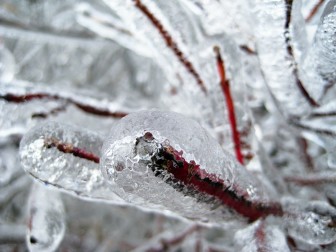This winter was pretty rough on everything, including the plants around Saucon Valley. As the full effects of the cold weather, ice and snow are becoming apparent, now is a good time to head out and look at the trees and shrubs on your property. The combination of freezing temperatures along with heavy snow and ice storms has resulted in a variety of plant damage. I have outlined a few of these below.
Desiccation of Plant Tissue or “Winter Drying”
This is probably the most common problem you will see around town. Broadleaf evergreens (holly, azalea, rhododendron. etc.) can lose water from the leaves (transpiration) during warm days in winter. The problem occurs when the soil is frozen and the water lost through foliage is not replaced because of the frozen soil. This results in desiccation of the foliage and wilted, brown or “scorched” leaves.
Low Temperature Injuries
The plants native to our area can do just fine in frozen weather–they spend all fall preparing for the winter, and if they are healthy, they stay dormant all winter and “wake up” just fine in the spring. But young plants and non-native species can have a difficult time in the sub-freezing weather. The root systems of these plants are especially sensitive to low temperature injury. When there is no snow cover, root damage may occur on plants during prolonged cold periods. It will be hard to assess root damage due to freezing temperatures until mid-spring. If you suspect damage, have a certified arborist or landscape professional look at your plants as they leaf out.
But young plants and non-native species can have a difficult time in the sub-freezing weather. The root systems of these plants are especially sensitive to low temperature injury. When there is no snow cover, root damage may occur on plants during prolonged cold periods. It will be hard to assess root damage due to freezing temperatures until mid-spring. If you suspect damage, have a certified arborist or landscape professional look at your plants as they leaf out.
Deicing Salt Injuries
This winter there was a lot of sanding and salting of the roadways, parking lots and sidewalks. Salt can cause serious injury to plants. High levels of salt in the soil from pavement runoff can dry out and kill plant roots. Sodium is toxic to plants. Salt spray from passing traffic can also “burn” plants adjacent to roadways.
Animal Injuries
Deer browsing can cause injury to the trunk, leaves and twigs of trees, especially in snowy winters. Rabbits and rodents can also damage the lower stem and root collars of plants in winter. If the stem is girdled, the plant will often wilt and die suddenly in late spring or early summer.
Breakage from Snow and Ice Accumulation
Trees and shrubs without proper growth structure are prone to breakage due to the weight of ice and snow. As you are out looking at your plants this spring, make sure you look for damage and try to address it as soon as possible.
Robert Andreucci is a local science teacher and arborist. Follow him on Twitter: @ScienceMrA.






